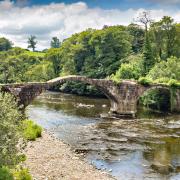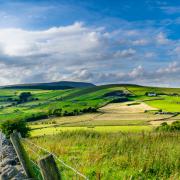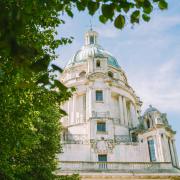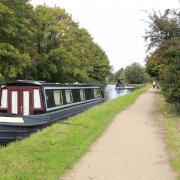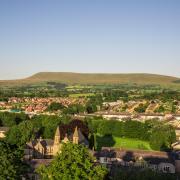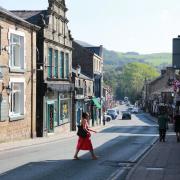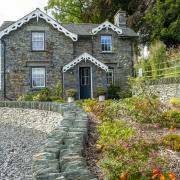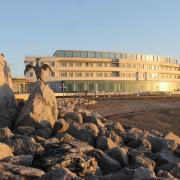Ambleside’s iconic Bridge House is due to re-open as two heritage groups launch a new collaboration
It must be one of the most photographed little buildings in the world. And even before the invention of the camera it attracted the interest of artists, inspiring JMW Turner among others.
But since before the pandemic Little Bridge House in Ambleside has remained locked and closed to visitors. Now that is about to change, with the iconic building set to become both a gift shop and gatehouse to one of the most extraordinary cultural collections in the Lake District.
The resurrection of the three-metre square, one-up and one-down building, due this summer, marks the start of a new collaboration between the National Trust and The Armitt Museum.
The structure and maintenance of the building will remain the responsibility of the National Trust which owns it but its day-to-day operation will be conducted by Armitt Museum staff and volunteers.
‘We are issuing a call to action for local people to come forward to support us,’ said Armitt curator and manager Faye Morrissey.

It will be open to the public and selling usual tourist mementoes like postcards, fridge magnets and tote-bags, but it will also act as an introduction to the Armitt collection housed just round the corner in Rydal Road.
Standing proudly over Stock Beck in the heart of Ambleside, the tiny house on the bridge has been used as an apple store, a cobbler’s and was once home to a family of eight.
It was built and the turn of the 17th and 18th centuries by the Braithwaite family who owned Ambleside Hall, replacing an earlier wooden bridge.

When Ambleside was dominated by weaving mills, it was used as a counting house. By 1819 it had become a tearoom and in the 1830s the Rigg family, “Chairy” Rigg, so-named as he repaired chairs, and his wife brought up six children there. The family died out in the 1850s.
In 1858 Harriet Martineau wrote in her popular Guide to the English Lake District: “the odd little grey dwelling… is the ancient house which is considered the most curious relic in Ambleside of the olden time… The view of the hill and rocky channel of the Stock … is the one which every artist sketches as he passes by”.
By the turn of the 20th century it was used by a cobbler or two. Then in 1927 it was acquired for £225 by a group of local residents, led by members of the Wordsworth, Collingwood and Rawnsley families. A further £470 was raised the following year to repair the building and add a strip of land to the west side of the beck.
They then handed it over to the National Trust, who first opened it to the public in 1956. It closed in 2019 as the National Trust had no-one to staff it.
One of the most famous artists to make use of the structure was German refugee Kurt Schwitters who arrived in the Lake District at the end of World War Two. Impoverished, he sat on the steps selling his paintings to passers-by. His defining painting of the quirky house is now part of The Armitt’s collection.

Tim Cowen, Chair of the Board of Trustees for The Armitt, said: ‘The Armitt is delighted to help open Bridge House in Ambleside to the public and to partner with the National Trust in expanding cultural development.
‘Part of The Armitt’s vision is to share the histories and stories of people and places in the Lake District to as wide an audience as possible. There is no more recognisable building in the Lakes than our neighbouring, iconic, “little house on the bridge”, which fits perfectly with our aspiration.’
The partners intend to work together to celebrate and conserve local culture following the work of their shared benefactors, including Beatrix Potter. As part of her legacy, she left her fungi drawings to The Armitt and 30,000 acres of land and 15 farms to the National Trust.
In another cultural collaboration between the organisations, historic farming photographs of the Langdales, from The Armitt’s archives, have been on show at the National Trust’s Sticklebarn, with plans to further extend the display over the summer as part of a three-year farming programme.
Another planned collaboration is the Ambleside’s Roman fort, Galava, which was part excavated by John Ruskin’s secretary WG Collingwood.
Laura Ruxton, General Manager for National Trust Central & East Lakes said: ‘By working in partnership with The Armitt, we hope to further share the fascinating history of the Lake District with everyone, and to preserve and conserve buildings like Bridge House for the future.
‘Bridge House has always played a special place in people’s hearts and we’d love the local community to get involved and join us in making this partnership a success so we can best tell the stories of the places that matter to us.’
The National Trust and The Armitt are calling for members of the local community, as well as visitors with an interest in celebrating and preserving the cultural history of the Lake District, to get involved with the project to re-open Bridge House, through volunteering, research and fundraising. If you’re interested, email info@armitt.com or call 015394 31212.








